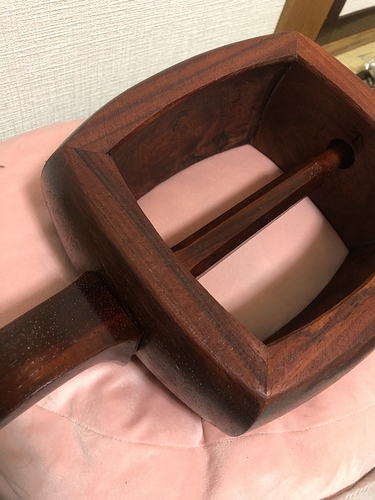I bought a “junk futozao” online recently and am hoping to repair it to a usable point. I noticed that the dou and sao are made of shitan wood which seems weird to me. Every traditional shamisen I’ve seen had a karin wood dou. Anyone else have experience/thoughts on a shitan wood dou?
Hi …
It’s not uncommon to find dou made out of so many different wood including Shitan(rosewood).
Shitan is not used for dou as it doesn’t make a lot of difference if any other wood is used and it’s not cheap to get so much wood for the dou.
Hope this makes it less wierd 
Hello, welcome.
If you’ve correctly identified it as shitan, that’s neat. Shitan is a harder than karin, which might lead to louder sound - but how noticeable it’ll be, well…
80% of the game is in the skinning, so you’ll like as not find it that much different.
Also your links are broken!
My connection out in north Hokkaido is bad during the winter but hopefully this time the photos work.!
I wonder if @Kyle_Abbott has any interest in this difference from the usual Japanese product? Maybe I thought this was more unusual than it really is haha.
Thanks for the tag, @Shamisengu! Wow, very interesting! I’m not surprised to see the diversity. A few years ago I bought a dozen junk shamisen (to repair and use for local classes) and was blown away to see how different they all were. Compared to shamisen made these days (which use more jigs and templates, methinks), it seemed there was more experimenting and creativity involved. For example, on one junk shamisen, half of the nakago was removed and in it’s place was a solid chunk of lead glued in.  On another, what seemed like a brass cube was inlayed into the tenjin kou. Needless to say, it was fun to see the whimsy. When I was just getting into shamisen making, I had assumed the construction process was a rigid and strict method, and the junk shamisen completely blew that notion away.
On another, what seemed like a brass cube was inlayed into the tenjin kou. Needless to say, it was fun to see the whimsy. When I was just getting into shamisen making, I had assumed the construction process was a rigid and strict method, and the junk shamisen completely blew that notion away. 
So as it relates to this dou. While karin is standard, the use of shitan could’ve easily been a request by the customer, or possibly an experiment by the maker.
Mr. @Brown hits the nail on the head (As the kids say) about how the skin plays the biggest role in the shamisen’s overall sound quality. That said, it might still be possible to hear a difference. In the past years, I’ve noticed there’s a correlation between skin tension and the hardness of the dou for getting the most balanced sound quality.
For example, Tokyo Wagakki (who, I believe, makes dou for most all high end tsugaru shamisen in Japan) dou uses harder karin which sound excellent with tightly stretched skin. It sounds fine with looser skin, but it really sings with tighter skin. (Of course, it’s a matter of taste too  )
)
Nichiwagakki shamisen (the deep red cheap tsugaru shamisen often fitted with a purple doukake and thick plastic skin) have very soft karin for their dou, and interestingly, tight skin sounds much worse on it. With the softer dou, tight skin sounds unpleasantly harsh and flat. However, loose skin somehow balances with the soft dou and is pleasant, warm and responsive.
This surprised me, as I tend to be suspicious of all the purported factors that influence sound quality. I still think that overall, skin affects 80% of the sound quality. But adding onto that, the hardness of the dou does have an important influence, and does need to be considered with the skin’s tension in order to bring the most balanced tone.
Trippy stuff!
And welcome welcome!
Wow! That’s some pretty crazy modification to the standard! Interesting that some dou have a better sound with loose skins, I’ll have to keep that in mind!

